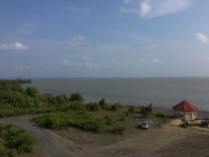Laem Talumphuk, or Talumphuk Peninsula, is a very out-of-way place, and has a little of an edge-of-the-world feel to it – albeit a sandy, mosquito-ridden edge of the world. Located about 50 km east of Nakhon Si Thammarat’s provincial capital of the same name, Laem Talumphuk Non-hunting Area is situated on a long, isolated peninsula, characterized by mangroves, sand coastlines, and scrubby casuarina forest. And while it’s not a destination to head for on it’s own, Pied Triller, a species not all too often encountered in Thailand can be found there, and the area does seem to also turn up decent migratory birds at the right time of year, making it a possible side trip to anyone visiting the better-known birding destination that is Khao Luang/Krung Ching.
Taking close to an hour to reach from Nakhon Si Thammarat town, the first thing one will notice is the isolation of the site. Just before reaching the non-hunting area, there is a small village – where I found a equally small guesthouse for the night – followed by a row of seafood restaurants right on the beach. I ate lunch at one of these restaurants, and it was delicious, but made the mistake of stopping just on dusk to have dinner as well. The restaurant owners were keen for the business, but warned me of the mosquitoes – I should have listened. I ended up scoffing down my dinner as the number of mosquitoes present once the sun went down was insane! During my quick dinner, I chatted with the restaurant owners, and they said that it is always like this, and that is why they are only open during the day.

After my lunch, however, I drove up to explore the non-hunting area, and was charged 20 baht to enter. Once past the boom gate, there is a visitor’s centre (I guess?) on the left, and the beach to the right, with car parks on both sides. A little further along the road on the left from the visitor’s centre is where the first mangrove walk is situated. It starts a little off the road, and there are no signs to it, but after I asked a few workers sitting around at the VC, they pointed me in the right direction.
The mangrove walk itself is a mix of concrete walkway, boardwalk, and sections where the path in on raised dirt embankments With my only to this site visit falling during the Spring migration, I found some decent birds along this small trail, including Yellow-browed Warbler, flycatchers, a nice Indian Cuckoo, Dollarbirds and Blue-throated Bee-eaters, along with the resident species which included Common Flameback, Ashy Tailorbird and the southern subspecies of Stork-billed Kingfisher which has a much deeper blue wing than its northern counterpart. Additionally, in the casuarina scrub in the is area, I also found Blue-winged Pitta, and this is also where Pied Triller is found, although I failed to connect with this species.
Driving further along the road that heads up the peninsula, you drive through more casuarina scrub, and after a while there is a lay-away where you can pull over to explore another concrete walkway on the right side of the road that goes through the mangroves. While I didn’t spend a lot of time here, I didn’t see all that much aside from the melodious Golden-bellied Gerygone.
The road up the peninsula ends at a car park, next to which is a viewing tower, and a trail that leads through the forest to the northeastern side of the peninsula which consists of a long, windswept beach and a hot, bare sandspit. Some nice views can be had from the tower, and during passage migration I found Crow-billed Drongo on my walk to the beach, but the highlight of this area lies on the beach and sandspit, as this is the place where rarer migrant waders and waterbirds can sometimes be found. And while there was not a whole lot of activity here when I visited, I was lucky enough to come across a single Chinese Egret, which made the hot slog over the sand worth it.
As mentioned earlier, Laem Talumphuk Non-hunting Area is by no means a site to head to on its on right, but if you’re adventurous, and especially if it’s during passage migration, then it can make for an interest side-trip for those that find themselves in Nakhon Si Thammarat, or the southeastern side of the peninsula in general.
My Checklists: April 4th, 2018 / April 5th, 2018 eBird Hotspot: Laem Talumphuk NHA
MY BIRD LIST (54 identified species)
- Lesser Whistling-Duck
- Spotted Dove
- Green-billed Malkoha
- Greater Coucal
- Asian Koel
- Indian Cuckoo
- Germain’s Swiflet
- White-breasted Waterhen
- Black-winged Stilt
- Whimbrel
- Common Sandpiper
- Caspian Tern
- White-winged Tern
- Whiskered Tern
- Little Cormorant
- Yellow Bittern
- Purple Heron
- Great Egret
- Chinese Egret
- Little Egret
- Cattle Egret
- Chinese Pond-heron
- Striated Heron
- Black-winged Kite
- Brahminy Kite
- Stork-billed Kingfisher
- Collared Kingfisher
- Blue-throated Bee-eater
- Indochinese Roller
- Dollarbird
- Common Flameback
- Blue-winged Pitta
- Golden-bellied Gerygone
- Malaysian Pied-Fantail
- Ashy Drongo
- Crow-billed Drongo
- Brown Shrike
- Large-billed Crow
- Common Tailorbird
- Dark-necked Tailorbird
- Ashy Tailorbird
- Barn Swallow
- Streak-eared Bulbul
- Yellow-vented Bulbul
- Yellow-browed Warbler
- Swinhoe’s White-eye
- Common Myna
- Great Myna
- Asian Brown Flycatcher
- Taiga Flycatcher
- Oriental Magpie-Robin
- Scarlet-backed Flowerpecker
- Brown-throated Sunbird
- Eurasian Tree Sparrow














